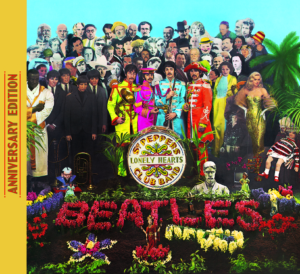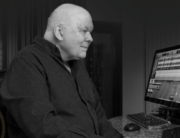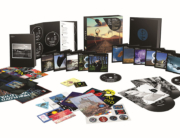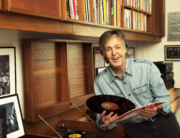BY MIKE METTLER – JUNE 1, 2017
 Believe it or not, the most important date in popular music history is Sunday, June 1, 1947. That’s the exact date Paul McCartney refers to in the title track of The Beatles’ seminal 1967 album Sgt. Pepper’s Lonely Hearts Club Band when he sings its opening line: “It was twenty years ago today, Sgt. Pepper taught the band to play.” Always literally and figuratively ahead of their time, those four lads from Liverpool were — and still are.
Believe it or not, the most important date in popular music history is Sunday, June 1, 1947. That’s the exact date Paul McCartney refers to in the title track of The Beatles’ seminal 1967 album Sgt. Pepper’s Lonely Hearts Club Band when he sings its opening line: “It was twenty years ago today, Sgt. Pepper taught the band to play.” Always literally and figuratively ahead of their time, those four lads from Liverpool were — and still are.
Recently, I sat down with producer Giles Martin in New York to discuss the new 50th anniversary mixes he and mix engineer Sam Okell did for Sgt. Pepper, which celebrated its 50th anniversary on June 1 (perhaps you heard about it. . .?). Our 5.1-centric chat about the hi-res 96/24 surround sound mix he did for both the Blu-ray and DVD included in the Sgt. Pepper box set appears in my Audiophile column on Digital Trends. Martin and I discussed a few other things together, of course, and that part of our Sgt. Pepper pow-wow now appears here exclusively on The SoundBard. A splendid time is guaranteed for all, as the saying goes. . .
Mike Mettler: Let’s talk about the new stereo mix you did for Sgt. Pepper. The original stereo mix done in 1967 was essentially considered to be an afterthought — so no pressure on you for this update, right? (both laugh)
Giles Martin: First of all, there’s no such thing as a “perfect” mix, despite what the audiophiles say. (both laugh again) Like, I love how [1973’s] Fresh by Sly and The Family Stone sounds, even though it is all over the place — but it feels great, do you know what I mean?
There are elements in the Sgt. Pepper stereo mix that I love — the vocal panning in “A Day in the Life,” for instance. But there is that sense of immersion to the mono mix, which actually has a three-dimensional element to it. You feel like you’re sinking into the speaker. We’ve tried to do that with the stereo mix so that we have the width as well. But it’s just music coming out of the speakers; that’s all it is. How that makes you feel is our drive.
Mettler: Another point you’ve made is that these are four gentlemen playing together, which people may not be thinking about when you’re talking about recording in a studio. When they think of Sgt. Pepper, they might think of it as a studio construct where the band wasn’t working on it together, but rather in piecemeal.

The lads you’ve known for all these years. . .
Martin: Yeah, people don’t realize the fact that they made Sgt. Pepper’s because they had been on tour for years, constantly — and they could play, because everything is live.
Even I — and I know their stuff pretty well — I was surprised to find, for instance, on “Being for the Benefit of Mr. Kite!,” it’s Paul playing bass, Ringo playing drums, John singing, and my dad [Sir George Martin] playing harmonium. Paul’s playing live, but I had always thought that bass was an overdub, because it’s pretty complicated.
Mettler: This album contains some of the most complicated bass lines in popular music, in fact.
Martin: It does. And we now have the benefit of hindsight about it all. For example, “With a Little Help From My Friends” — the bass is on the right-hand side, on the stereo version. One of my things was, we can’t put the bass and the drums in the center and put the vocals in the center, and then have other things on the sides. When we put the bass in the center, Ringo’s voice didn’t sound as good with the bass with it in that same field. It’s weird how that changes the sound of things. The panning can change the sound of an instrument. And the bass in that song is kind of a lead instrument anyway; it’s not really a bass [i.e., support].
And so, like on the original stereo, I kept it on the right-hand side. Actually, Sam [Okell], the mix engineer, had it on the right-hand side and I had moved it to the center, but it was completely wrong. And then I was like, “Oh God, I’m wrong — again.” So we moved it back.

Getting Better: Giles Martin in repose, during a rare mixing respite in Studio Two at Abbey Road.
Mettler: Good that you had Sam as your counterbalance there. We’ve talked about the surround mix you did for LOVE before. How much of that colored or influenced what you did with the Sgt. Pepper 5.1? Or were those two separate ideas to you?
Martin: Two separate ideas. LOVE, I had a huge advantage over, because I could do so much stuff with it. As I said to Sam, with LOVE, if I felt like I needed to fill in the surround spectrum, I’d add more stuff to it — like I was making a curry, you know? (both laugh)
When we did the 5.1 for The No. 1s [i.e., The Beatles’ 1+ Blu-ray edition], we were kind of “saved” quite often, because we only had three or four tracks there. They sounded pretty good, but they were safe.
With Pepper, here’s the thing — and this was always my starting point — I would say, “OK, if it’s not me and I was told someone was going to do a 5.1 of Pepper, my expectations would be pretty bloody high,” especially if I were a naysayer.

Pepper Preppers: The Beatles at work.
Mettler: Well, this is the most storied album in popular music, so. . .
Martin: Yes. And because of the way we work, you can hear the individual elements. There’s less limiting, and gluing everything together. You can hear everything much clearer. For example, we did things with ADT [automatic double tracking] and the tambouras [lutes that supply a droning sound, not unlike what you hear in Indian music] in “Getting Better,” moving them around to have a swirling effect and more layered material for the 5.1. But we did the stereo first, because the 5.1 needed to sound like a 5.1. The 5.1s on the 1+ collection sound like the stereo with space around them. They’re cool, though — but they’re safe.
Mettler: That’s true. Whereas when I put the Pepper 5.1 on, I feel more like I’m in the middle of what’s going on there.
Martin: The idea with Pepper was to do just that. We also did an Atmos mix of it, which I thought would be fun to do, since we were in the zone. That way, we can play it in cinemas on the big screen, turn out the lights, and put it on.
Mettler: Oh man, I want that experience at home at some point.
Martin: Right? It’s funny how people reacted to that. Jeff [Jones] and Jonathan Clyde at Apple all went, “Wow. . .”
Mettler: I would have too. We should also mention the surround mixes you did for “Strawberry Fields Forever” and “Penny Lane,” both of which are included in the Sgt. Pepper box set. Both tracks were, of course, not on the original album, but came out a few months earlier [in February 1967] as a double-sided single.
Martin: The surround version of “Strawberry Fields” on 1+ is what I call the “cheating” version. We went and redid it for inclusion on Sgt. Pepper. We remixed it — both that, and “Penny Lane” — because we wanted to be braver. For “Penny Lane,” we found this early-generation tape that I had never heard before, which has Paul playing four pianos, We only found it halfway through making it.
Mettler: Now I can say “wow” myself! Finally, and I do have to ask you this, what’s coming next for The Beatles in 5.1? Would you do the entire catalog in 5.1 if you could?
Martin: Well, it’s not up to me. It’ll be up to people wanting it, do you know what I mean? I’m always concerned about people thinking, “Who the hell does this guy think he is?” I’m probably the one person in the world who feels uncomfortable doing it. I mean, I’m not doing it because I think it’s a great job opportunity. It’s more of a legacy thing.
But, honestly, I don’t know what the next thing is. But I can say there will be more 5.1 Beatles stuff, yes.






